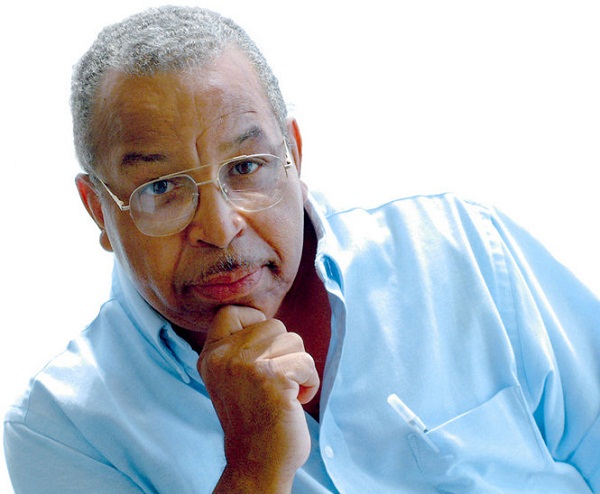 |
| Charles Simms Jr. Image via NOLA.com | The Times-Picayune |
Charles Simms, New Orleans expressionist artist, has died
New Orleans artist Charles Simms Jr., known for his expressionist paintings, died Saturday (Nov. 17) of cancer. He was 75.
In a July 2012 YouTube video interview during a solo exhibition at the New Orleans African American Museum, he said he selected subjects that “affect me or are about the African-American community.” The large scale of his paintings and his passionate brushwork lent glimpses of ordinary life, such as children at play on neighborhood sidewalks or the social interactions inside a McDonald’s restaurant, a certain heroic importance.
In a July 2012 YouTube video interview during a solo exhibition at the New Orleans African American Museum, he said he selected subjects that “affect me or are about the African-American community.” The large scale of his paintings and his passionate brushwork lent glimpses of ordinary life, such as children at play on neighborhood sidewalks or the social interactions inside a McDonald’s restaurant, a certain heroic importance.
Simms’ art has appeared at the Contemporary Arts Center, the McKenna Museum of African American Art, The New Orleans Museum of Art and other Crescent City institutions.
Three of his paintings are part of the collection of African American art at Dooky Chase restaurant. Art collector Leah Chase recalls that the restaurant was not only a museum space for Simms, for a short time, it was a temporary studio.
Years ago, she said, Simms made sketches in the neighborhood around the restaurant, then refined the drawings while seated inside. Chase said that she sought to buy paintings from Simms, but he declined. “He said, ‘No, I don’t sell my work,’” Chase said. “’but I’m going to let you use them; put them on the wall.’”
Simms’ son Charleston Simms said that his father chose to keep his entire artistic output as a complete collection. He saved many of his 300-plus paintings from 2005 flood waters following Hurricane Katrina by moving them to the second floor of his eastern New Orleans home. Others got wet, but were salvageable.
Artist Richard Thomas, best-known for his enormous Louis Armstrong New Orleans International Airport mural, describes Simms as an “unsung hero” of the New Orleans art world. Thomas said he admired Simms for his ability to produce art in his characteristic “loose expressionistic style with, wiry, long brush strokes” and also to be able to add abstract flourishes when he wanted to.
Considering most artists’ eagerness to sell their work, Thomas was surprised by Simms’ reluctance to part with his paintings. Thomas pointed out that Simms’ second career as a post office clerk made it possible for him to keep his collection intact. In one series of works, Simms created self-styled postage stamp designs.
I want to effectively record through paintings my existence in the last half of the 20th century.
Simms was born Dec. 18, 1936 and grew up in the Lafitte public housing development. In a brief online autobiography at fineartamerica.com, Simms recalls that his artistic awakening took place in Mr. Magee’s third grade class at McDonough 17 Elementary School, when he and the other students were asked to trace a drawing of St. George and the Dragon. His was the most accurate. He attended Booker T. Washington High School, then joined the Air Force where he had the good fortune to be based near Paris.
“I spent my first full leave exploring the basement of the Louvre Museum,” Simms wrote. “I remember walking for what seemed like miles, viewing, looking, and gazing at the miracles of mankind. Art was everywhere.”
Returning to New Orleans in 1959, Sims enrolled in college; first at Xavier University, then Southern University during the 1960s civil rights movement, where he has said he was made aware of the potential of artwork as a vehicle of by political commentary by professor Jack Jordan.
“Loosely put,” Simms wrote in his fineartamerica.com autobiography, “I want to effectively record through paintings my existence in the last half of the 20th century. I want the world of tomorrow to see the world of today as seen through the eyes of an African-American artist.”
Artist and Xavier University professor Ron Bechet said that Simms’ work was subtly critical of undue corporate influence on society and other social ills and inequities. Bechet said that stylistically Simms reminds him of another African-American genre painter Paul Goodnight. But, Bechet said, “Charles had a little more social bite.” For example, Bechet said, Simms’ “intensely emotional” painting “The Night Caller,” depicts the unspecified distress of a woman with children at a pay phone at night. “You get the feeling of this woman and the troubles she’s going through,” Bechet said. “He could catch some of the things that were going on in her life.”
But, Bechet said, Simms was just as adept at capturing the joyousness of Crescent City cultural traditions, such as family picnics and marching bands. His works, Bechet said, were “very much about this place.” In 1962, Simms married his childhood sweetheart, Lula Mae Sullivan and in 1968 found work with the U.S. Post Office; a career that lasted for decades. Simms' family has not yet discussed future plans for the collection of his paintings.
A funeral for Charles Simms Jr. takes place Saturday (Nov. 24) at Charbonnet-Labat-Glapion funeral home, 1615 St. Philip St. with a viewing at 10:30 a.m., followed by a “celebration of life” tribute from noon to 1, when a jazz procession will lead to St. Louis Cemetery No. 2. Afterward a memorial repast takes place at the African American Museum, 1418 Governor Nicholls St., from 1 to 5 p.m.
Simms is survived by his wife Lula Mae Sullivan Simms, son Charleston Simms, daughter Charlinda Matthews, and daughter Cheyra Pennette.
YouTube: Charles Simms Gallery Interview
No comments:
Post a Comment